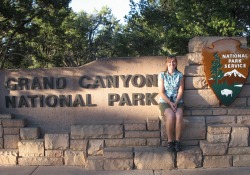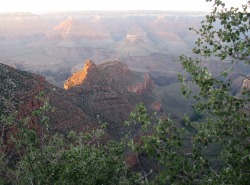|
During the week of Monday, July 20th, GRTE hosted a series of lectures at the Colter Bay Visitor Center Auditorium. I attended three of these lectures. Monday evening I was kayaking down the Snake River so I missed the first one.
Tuesday, July 21st "Inventions, Treasures, Indians, & Presidents: Washington's Civil War Era Patent Office Building" Guest Lecture by Dr. Douglas Evelyn, HIstorian The Patent Office was the original site of the "Home" Department, or all domestic aspects of government, including the Department of the Interior which oversees the National Park Service. The building was designed as an exhibition hall, and it is for this reason Dr. Evelyn argues that it survived threats to tear it down in the 1920's and again in the 1950's. A few illustrious employees of the Office included Clara Barton and Walt Whitman. The Patent Office was converted into a bunker for soldiers, warehouse for provisions, and host for "Sanitary Fairs held on the upper floors by prominent D.C. women during the Civil War. The building now houses the Smithsonian's American Portrait Gallery and the American Art Museum. Wednesday, July 22nd "Exploring the West" Guest Lecture by Dr. Herman J. Viola, Curator at the Smithsonian's Museum of Natural History Dr. Viola applauds government employees for the exploration of the West. From soldiers, surveyors, scientists, and mapmakers, these expeditions paved the way for settlement and were among the first to interact with American Indians. I was shocked to learn that P.T. Barnum had purchased the Lewis & Clark Expedition materials from the Peale family at an auction. The Peale's in turn had received the collection from Thomas Jefferson. A fire consumed the collection in 1865 while under Barnum's ownership. A lesser known expedition was conducted by Charles Wilkes, a naval officer, whose priority was to chart the seas, creating independent records from Brittish rivals. The Wilkes expedition was the first time civilian scientists worked with a military expedition. Among them was James Dwight Dana, an early American Geologist, and Titian Ramsey, an artist, naturalist, and consequently the son of Charles Peale, who had been friends with Jefferson and entrusted with the Lewis * Clark Collection. The Wilkes Expedition influenced Herman Melville, who used the painted shape of an Antarctic snow drift as the basis for Moby Dick, "the great white whale." James Fennimore Cooper also wrote a book about the sea based on the expedition. Dr. Viola noted that Wilkes did not receive a commemorative USPS stamp until 1985, while Lewis & Clark received one in 1954 and John Charles Freemont, a Republican expansionist who opposed slavery, in 1890. Ferdinand Hayden, a geologist, is credited with early exploration of the Greater Yellostone area. Accompanying Hayden were two artists, William Henry Jackson, a photographer, and Thomas Moran, a painter. The art these two men produced was displayed in Congress and instrumental in establishing Yellowstone as America's first National Park. Thursday, July 23rd "Search for the White Clay People" Guest Lecture by Mr. George Horsecapture of the A'aninin or Gros Ventre Tribe Mr. Horsecapture focused on the Gros Ventre Tribe (pronounced "grow vawnt"), who broke apart from the Arapaho in 1650 and were allied with the Blackfoot. He addressed the Bering Strait theory as an explanation for prehistoric human presence in North America and stated that migration "assumes you know where you are at and where you are going. Mr. Horsecapture employed humor as a way for the audience to identify with cultural differences. "Gros Ventre" comes from a French word meaning "big belly." They were so named by French trappers who misinterpreted hand signs for "waterfall people" as the A'aninin first encountered whites on the Saskatchawan River. The White Clay People originally ranged from Canada to the Cimarron River. Today, many live on the Fort Belknap Indian Reservation in north central Montana. Fort Belknap is 25 miles by 40 miles in size. The U.S. government often placed tribes who historically fought against each other on the same reservation. This is true of the Arapaho and Shoshone who coexist on the Wind River Reservation south of GRTE. Mr. Horsecapture credits E. S. Curtis, a visual anthropologist, for taking 40,000 some images of Amerian Indians. Among those images is Horsecapture's grandfather. Horsecapture served as the curator of the Plains Indian Museum at the Buffalo Bill Historical Center in Cody, Wyoming. I recently visited the museum and was blown away by its depth. There are actually five museums in five wings of the museum including the Plains Indian Museum: The Draper Museum of Natural History, The Whitney Gallery of Western Art, The Buffalo Bill Museum Collection, and The Cody Firearms Museum. Check out www.bbhc.org for virtual collections. Overall I was impressed with the lecture series, and learned something new at each one. I feel that the lectures and the trip to Cody contributed to my understanding of GRTE in a historical context, the legacy of museums, and how the organization of information contributes to an understanding of history--whether that understanding is misinterpreted, misinformed, or simply available for those to draw their own conclusions. The Buffalo Bill Historical Center includes the McCracken Research Library & Archives. I am interested in how the library and archives interacts and informs the museum exhibits and interpretation. For a synopsis of the lecture series and more on the careers of the speakers: http://gtnpnews.blogspot.com/2009/07/david-t-vernon-collection-special.html
0 Comments
During the course my internship with Grand Teton National Park (GRTE) I have been working with digital images of The Vernon Collection, on display at the Colter Bay Indian Arts Museum. The Skinny Moose has a few things to say about losing our history. Check out the skinny moose blog for details on the new National Park Service Superintendent. Greetings from the Colter Bay Curation Office in Grand Teton National Park. I am currently completing a "cultural resources" internship with Alice Hart, museum curator. I will be here through the second weekend in August. The project I am working on was "inspired" by a directive from the Department of the Interior, or, "the folks in Washington," who have mandated that National Parks step up their record keeping for scientific research being done in Parks. For example, 53 research permits have been issues since January 1, 2009 of those, only 13 permits are new, the rest are classified as "renewals," many of which are issued for longitudinal research. The products of this research, including (but not limited to): specimens, raw data, field notes, dissertations, journal publications, etc. are often lost in the shuffle. Although NPS requires Investigator Annual Reports (IAR's), the bulk of the data may end up in a professor's office, uncataloged and untraceable. I believe NPS envisions a nationwide publicly accessible (that means you don't pay $40 for access to one journal article) database that includes records of all research completed within Parks--which are, after all, publicly owned. |
AuthorJenny Gapp, has twenty years experience as a teacher librarian, four seasons as a seasonal state park ranger assistant, and two summers adventuring with National Parks in an official capacity. Archives
February 2024
Categories
All
|


 RSS Feed
RSS Feed



